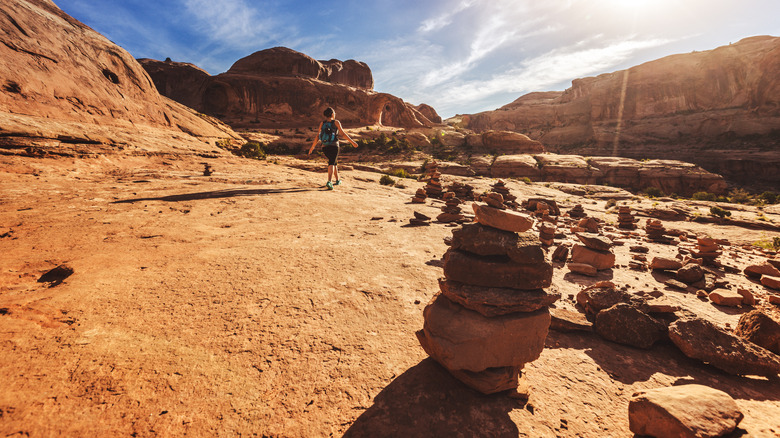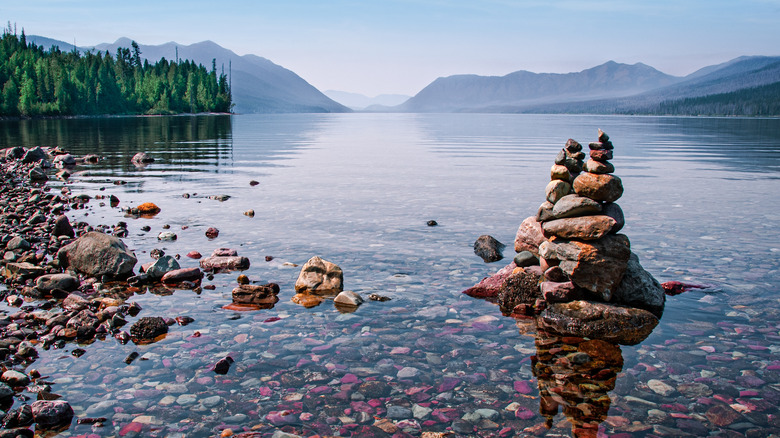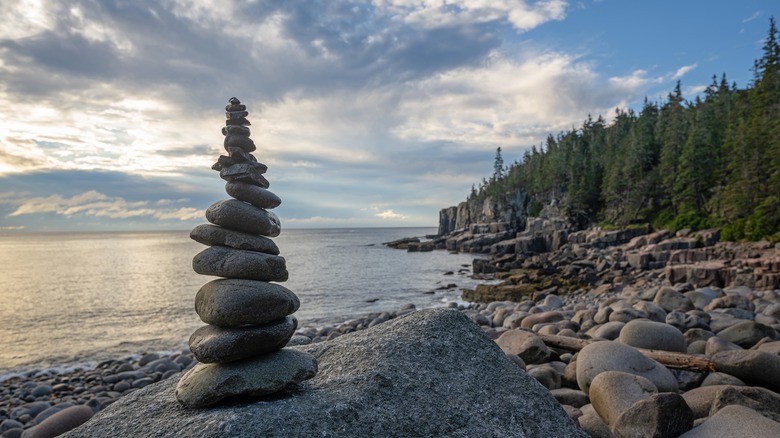This Common Stone-Stacking Activity Becomes Prohibited And Dangerous In A National Park
National parks are some of the rare places left in the United States where you can experience how it looks and feels to be in nature that is mostly undisturbed by human interference. Being so immersed in a postcard-worthy scenery of a unique national park can make it extra jarring to spot something clearly made by people. So when you spot a pile of rocks by the side of a trail, you're probably curious why somebody made it. These formations are known as rock cairns. Some are small, just a little tower of rocks stacked on top of each other, while others are enormous mounds of stacked up stones. It might be tempting to try making your own, but unfortunately, doing so disrupts the environment and could even put your fellow hikers in danger.
Some cairns are official and maintained by park rangers, but many more are simply made by visitors to the park who find it enjoyable. There's some debate about what should be done about existing cairns that have been made by visitors, but when it comes to making new ones, the National Park Service has been very clear: Don't do it.
Unofficial cairns can put hikers in danger
It might seem confusing that some of the best national parks that you visit, like Hawaii Volcanoes National Park and Carlsbad Caverns National Park, promote the use of cairns but won't allow you to make them. The reason is actually very simple, though: Official cairns are used to keep backpackers hiking through remote areas of the park from getting lost. Park rangers maintain some of these stone stacks to make sure that nobody wanders off the trail and into a dangerous area. If you're stacking up your own for personal reasons, it has the potential to confuse hikers about where they're supposed to go.
In Acadia National Park, it was reported by Keep Nature Wild in 2018 that some visitors were actually knocking down official cairns to make their own, which means there's no way for hikers to be sure they're following an official trail. On some iconic but dangerous national park hikes, accidentally wandering off the trail can put you at risk of running out of supplies while trying to get back on track (and it's not good for the environment to have too many hikers repeatedly stomping around off-trail trying to find their way back). Some even fear that on mountain hikes, putting stacks of rocks at the summit could be extremely dangerous. Even small stones toppling off the top of the mountain could be an issue for climbers on sheer cliffs below. Some worry that a few falling rocks could pull more down with them, too.
Stone stacking is disruptive
Aside from causing safety issues to your fellow travelers, changing the environment is disruptive, even in seemingly small ways like stacking up stones. While one or two rock towers might not be too serious, unfortunately, building them has become a trend. Since the early days of social media, posts of cairns have encouraged others to stack them up, too. When hundreds of visitors are moving the rocks around, there can be issues.
In a 2018 Facebook post, Zion National Park explained why it doesn't want visitors making rock stacks in the park, stating: "Visitors who build cairns probably don't look at building cairns as vandalism since rocks can be unstacked easily, but moving rocks around still can lead to resource damage by exposing soil to wind and water erosion. Moving rocks also disturbs the many critters that make their home in the protected underside of a rock."
When most people visit a national park, they're hoping to get closer to nature, and the last thing they want to see is something made by people. The National Park Service asks all of its visitors to follow Leave No Trace principles, which encourages those in the wild to leave things exactly as they found it. That includes not taking mementos out of the park, not leaving your trash behind, and yes, not leaving little rock towers around the park.


